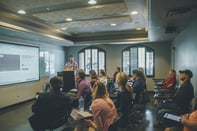Published on
Fostering the Lifelong Learning Model with Continuing Education

The lifelong learner needs short-term programming that they can access throughout their career journey. To help meet this need, higher ed needs a good understanding of lifelong learning and continuing education to begin developing programming and services that will help them be successful. In this interview, John Galiotos discusses developing non-credit programming and support services, bridging non-credit with credit and growing Continuing Education.
The EvoLLLution (Evo): What are some of the key obstacles to developing programs and support services designed specifically for non-traditional or non-credit learners?
John Galiotos (JG): There are several obstacles, but the most important is awareness. Educational institutions still go with the old, traditional way and therefore don’t have a good understanding of what Continuing Education is, that it is lifelong learning. It is either a matter of not really understanding it or not wanting to understand it because we still use traditional ways of providing education to our students. You graduate from high school, do a credit, come to college, measure numbers, students coming in, students coming out. All of this data is used to promote the university’s success, but the university’s success depends on lifelong learning.
The second one, possibly on equal level, is the existing silos between credit and non-credit. Building bridges from one to the other is paramount. If that happens, things would be much, much better and more productive.
Evo: What’s stopping those bridges from coming into existence today?
JG: Accreditation has nothing to do with it. Accreditation—whether it’s ABET, SACS or any other—doesn’t distinguish between these two, but internal personnel does. The question is, “What is the percentage of faculty teaching relevancy in the classroom?” And it’s small. By the time you assign a book or conduct a lecture, the content of that book or lecture might be obsolete the week after. So, faculty need to continually be educated and trained on the current trends in today’s technology and science, as well as the field of their specialization.
It does not matter what they teach—it is a form of continuing education for faculty. How can I say that I am continually improving my knowledge, so I can become a better professor and expert in my field, if I don’t really pay attention feel that strongly about my own continued education? CE is lifelong learning, continuous learning.
Evo: What are the most significant opportunities on the horizon for continuing ed divisions of regional institutions?
JG: I had help developing credit and non-credit bridging strategies, presenting a bridging plan for Advanced Manufacturing and Manufacturing Engineering and Technology. No one can persuade me that if a student comes to an institution and learns all the basics and more of how to program and operate and lathe or milling machine, maintains a huge unit to fabricate a piece of metal to something useful, this knowledge is not equivalent and more to Introduction to Manufacturing, for example. So, faculty need to work with credit and non-credit alike, identify the skills, competencies and learning outcomes that a student must possess.
When you go through any Continuing Education course, you learn that, at the end of this course, you will be able to identify, describe, analyze, operate, maintain, troubleshoot, assemble—all of the action verbs of introductory courses for credit. So, there’s a bridge right there. Then you tell the person, “Listen, if you want to continue your education to earn an associate, bachelor’s, master’s or whatever, this particular knowledge that you have counts.”
Second, let’s say I’m a chemical engineer, and I know the unit operations inside out. Then I go to the college and say, “I have so many years of experience and I want to get my associate degree. I’ve never gone to school, but I have a number of certifications.” The chairperson of the institution can say, ” Great, we have a program where we give credit for experience, and we can give you up to 21 credit hours if you provide evidence.” So, I come in with a stack of certificates and evidence from my previous industry experience, and now I have a bridge.
If I get 21 credit hours, then I need another 40 credit hours for an associate’s degree, correct? There should be a continuous bridging collaboration between the faculty who approve credit and non-credit to build these bridges. It’s not a matter of the president or the vice-president—they may not know anything about this kind of stuff. It’s a matter of the professors and the faculty, the chair and the dean.
The other thing is that credit classrooms, labs and workshops have computers and equipment that non-credit students do not even dare touch. We have facilities that are not utilized because of this paranoia. And that really hurts the industry and the students’ knowledge, and it just does not correlate with the institutional mission, vision and goals. All of these must be bridged altogether and undergo the optimization process to see what is used most and less, implement improvements and move forward.
Evo: When you look at an organization like NCCET, how are these associations important to the growth of Continuing Education?
JG: It’s a coalition that should create opportunities and develop initiatives that bring everybody to the table to make certain that Continuing Education is lifelong learning and reflects the mission of every institution in the country, no matter whether it is Harvard or another institution. Colleges, universities and NCCET need to promote best practices and initiatives that support them. NCCET if I may, should also be about outcomes that I can see and utilize and make me eager to become a member.
Further, NCCET should become the brokers of resources between industry, education and the community. Link them together, so the actions and outcomes that are most quantifiable and qualifiable really inspire institutions to join these organizations and actively participate in them.
Evo: Is there anything you’d like to add about the opportunity for Continuing Education and some of the challenges that leaders face?
JG: Continuing Education has to be global. We should learn about best practices elsewhere. I have traveled around the world, except Africa, and Continuing Education elsewhere is so well linked to the prosperity of both the community and that of the institution. And a number of essential and applicable certifications and certificates are awarded through Continuing Education. Therefore, these certificates and certifications are valuable to industry and enhance the trainee’s marketability. As an engineer, every year I have 20 hours of continuing education in order to maintain my PE, so how does that stand in a credit side? Say, “I will need to do a continuing education, but I don’t accept you as the entity offering this type of education”? Come on, it’s paranoia.
Continuing Education needs to innovate more. Take examples from outside the world, and see how others operate. Sometimes there’s an overlap with corporate training as well. Corporate training is a one-time deal. I come to you for you to train me for two weeks on a particular piece. That’s fine—corporate training can evolve into Continuing Education. So, we need smart initiatives and interactions between institutions based on facts, outcomes and best practices that then generate measurable outcomes.
So, NCCET should have a boot camp for administrators. They could also partner with major initiatives, such as the various federal departments, World Federation of Colleges and Polytechnics and such, to provide tangible outcomes that we can use. The other side of the coin is that they need to let the world know of the impact and intellectual merit they can provide. With actions and practices from the past, I’m doing what NCCET is preaching without even knowing it.
This interview was edited for length and clarity.
Disclaimer: Embedded links in articles don’t represent author endorsement, but aim to provide readers with additional context and service.



